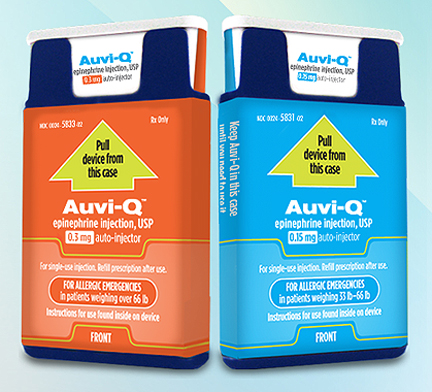The first-line defense against anaphylactic shock is an epinephrine injection, and patients have to act quickly. Sanofi’s just-approved auto-injector gives patients an added boost—called, Auvi-Q the device talks patients through the injection process.
The approval marks the first injector that comes with audio guidance: as shown in an instructional video, directions start once a patient has yanked off the outer covering. This triggers a four-step set of instructions that includes removing the injector guard, instructions to firmly place the device against the outer thigh, a five-second injection countdown, and the direction to seek emergency medical assistance.
It’s the latest entry in a competitive market. A quick web search for epinephrine auto-injectors generally brings up three names: Epi-Pen (Dey Pharma), Twinject (Core Pharma/Amedra) and AdrenaClick (Amedra/CorePharma). Sanofi’s edge include the added benefits of size and aural communication
The injector is currently available in English, per the FDA’s Monday morning approval. Sanofi told MM&M that it was too early to discuss marketing details and possible line extensions for the credit-card sized device, but said it expects to have that information ironed out later this year.
The move makes sense, not just from an ease standpoint, but from a marketing one—about 6 million Americans are at risk of suffering from the allergic reaction known as anaphylaxis, estimates show. Futher, a study published in the April 2012 Journal of Allergy and Clinical Immunology noted that there has been a spike in the number of people suffering from food-related allergies, which can trigger anaphylaxis reactions, such as hives and stomach pain, as well as restrict airways, making it difficult for patients to breathe.
Authors of the April study found that childhood food allergies were on a steady rise from 1997 to 2008, citing as examples a rise in tree nut allergies that crept from 0.2% of children to 0.5%, and then to 1.1%. Childhood peanut allergies also rose, going from 0.4% in 1997, to 0.8% and then to 1.4% over a decade. The study also noted the increase hasn’t been limited to the US—food-related anaphylaxis rose 350% in Australia from 1994 to 2005. Food isn’t the only potential culprit—shellfish, dairy and eggs are also common triggers—but it is a common one. Latex and insect bites can also ignite an allergic response.
Despite the diversity of possible triggers, there is one key treatment. “I always tell people to repeat after me that the treatment of choice is epinephrine…what’s the first choice? Epinephrine. What’s the second choice? Epinephrine? What’s the third choice? Epinephrine,” Richard Lockey, the director of allergy and immunology at Morsani College of Medicine in Tampa, FL, told MM&M.
Lockey noted that auto-injectors include some downsides. He found wholesale prices of the devices rose markedly between 1985 and 2012. Based on his examination of prices listed in the Micromedex Red Book, in 2011 dollars prices rose from between $30 and $110 in 2003-2005 to $54.50 to $168.66 in 2007, the allergist wrote in a Journal of Allergy and Clinical Immunology op-ed. California-based Kaiser Health Systems say costs have kept patients from filling auto-injector prescriptions, a point Lockey’s July op-ed also made.
But Lockey told MM&M that he looked into the pricing issue because his own patient said the costs were too high. His solution is to bypass auto-injectors and teach patients how to fill syringes. He said it’s cheaper and it helps patients “give a more optimal dose,” because it can be customized for each patient. He also noted that auto-injectors may be less effective for obese patients because of dosing issues.
A Sanofi representative said the company hasn’t settled on a price yet for its new auto-injector but that a patient’s insurance plan really determines the cost.








